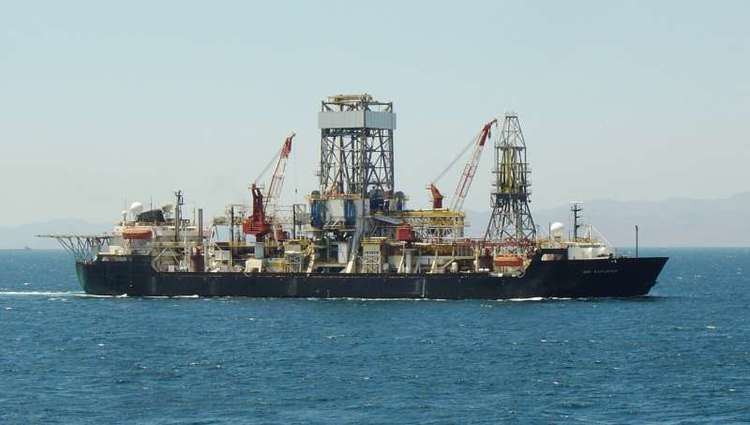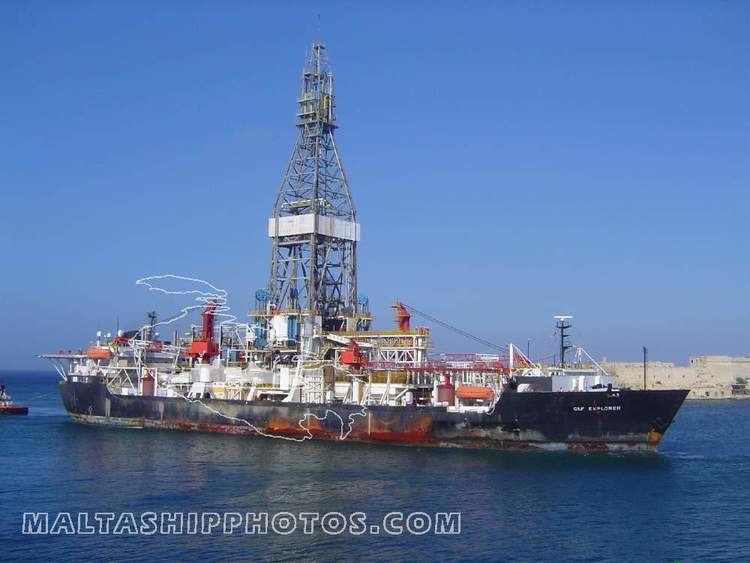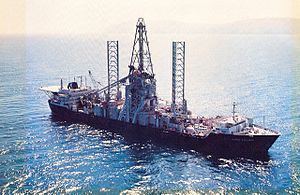Name GSF Explorer Operator Transocean Cost $350 million + Launched 1 November 1972 Builder Chester | Owner Transocean Port of registry Vanuatu, Port Vila Laid down 1971 Length 189 m | |
 | ||
GSF Explorer, formerly USNS Hughes Glomar Explorer (T-AG-193), was a deep-sea drillship platform initially built for the United States Central Intelligence Agency Special Activities Division secret operation Project Azorian to recover the sunken Soviet submarine K-129, lost during April 1968.
Contents

The cultural effect of Glomar Explorer is indicated by its reference to a number of books: The Ghost from the Grand Banks, a 1990 science fiction novel by Arthur C. Clarke; Shock Wave by Clive Cussler; Charles Stross's novel, The Jennifer Morgue; and The Hunt for Red October by Tom Clancy.

Construction

Hughes Glomar Explorer (HGE), as the ship was named at the time, was built between 1973 and 1974, by Sun Shipbuilding and Drydock Co. for more than US$350 million at the direction of Howard Hughes for use by his company, Global Marine Development Inc. This is equivalent to $1.7 billion in present-day terms. It first began operation on 20 June 1974. Hughes told the media that the ship's purpose was to extract manganese nodules from the ocean floor. This marine geology cover story became surprisingly influential, causing many others to examine the idea. But in sworn testimony in United States district court proceedings and in appearances before government agencies, Global Marine executives and others associated with Hughes Glomar Explorer project maintained unanimously that the ship could not be used for any economically viable ocean mineral operation.
Project Azorian
Because K-129 sank in very deep water, at a depth of 3.0 miles (4.8 km), located 1,560 miles (2,510 km) NW of Hawaii, a large ship was required for the recovery operation. Such a vessel would be detected easily by Soviet vessels, which might then interfere with the operation, so an elaborate cover story was developed. The CIA contacted Hughes, who agreed to assist.

While the ship did recover during 1974 a portion of K-129, a mechanical failure in the grapple caused two-thirds of the recovered section to break off during recovery. This lost section is said to have held many of the most sought items, including the code book and nuclear missiles. It was subsequently reported two nuclear-tipped torpedoes and some cryptographic machines were recovered, along with the bodies of six Soviet submariners, who were given a formal, filmed burial at sea.
The operation became public during February 1975 when the Los Angeles Times published a story about "Project Jennifer", followed by news stories with additional details in other publications, including The New York Times. The CIA, wanting neither to confirm nor deny the story, issued the Glomar response, which set the precedent for subsequent responses to Freedom of Information Act requests. The true name of the project was not known publicly to be Project Azorian until 2010.
The publication Red Star Rogue (2005) by Kenneth Sewell makes the claim "Project Jennifer" recovered virtually all of K-129 from the ocean floor. Sewell states, "[D]espite an elaborate cover-up and the eventual claim that Project Jennifer had been a failure, most of K-129 and the remains of the crew were, in fact, raised from the bottom of the Pacific and brought into the Glomar Explorer". A subsequent movie and book by Michael White and Norman Polmar revealed testimony from on-site crewmen as well as B&W video of the actual recovery operation. These sources indicate that only the forward 38 feet of the submarine were recovered.
Mothballing
While the ship had an enormous lifting capacity, there was little interest in operating the vessel because of her great cost. From March to June 1976, the General Services Administration (GSA) published advertisements inviting businesses to submit proposals for leasing the ship. By the end of four months, GSA had received a total of seven bids, including a US$2 million offer submitted by a Lincoln, Nebraska college student, and a US$1.98 million offer from a man who said he planned to seek a government contract to salvage the nuclear reactors of two United States submarines. These are equivalent to $8.42 million and $8.33 million in present-day terms, respectively. The Lockheed Missile and Space Company submitted a US$3 million, two-year lease proposal contingent upon the company's ability to secure financing. GSA had already extended the bid deadline twice to allow Lockheed to find financial backers for its project without success and the agency concluded there was no reason to believe this would change during the near future.
Although the scientific community rallied to the defense of Hughes Glomar Explorer, urging the president to maintain the ship as a national asset, no agency or department of the government wanted to assume the maintenance and operating cost. Subsequently, during September 1976, the GSA transferred Hughes Glomar Explorer to the Navy for storage, and during January 1977, after it was prepared for dry docking at a cost of more than two million dollars, the ship became part of the Navy's Suisun Bay Reserve Fleet.
Lease, sale and current status
During September 1978, Ocean Minerals Company consortium of Mountain View, California announced it had leased Hughes Glomar Explorer and that during November would begin testing a prototype deepsea mining system in the Pacific Ocean. The consortium included subsidiaries of the Standard Oil Company of Indiana, Royal Dutch Shell, and Boskalis Westminster Group NV of the Netherlands. Another partner, and the prime contractor, was the Lockheed Missiles and Space Company.
During 1997, the ship was taken to Atlantic Marine's Mobile, Alabama shipyard for modifications that converted it to a dynamically-positioned deep sea drilling ship, capable of drilling in waters of 7,500 feet (2,300 m) and, with some modification, up to 11,500 feet (3,500 m), which is 2,000 feet (610 m) deeper than any other existing rig. The conversion cost more than $180 million US and was completed during the first quarter of 1998. This is equivalent to $264 million in present-day terms.
The conversion of the vessel from 1996-1998 was the start of a 30-year lease from the U.S. Navy to Global Marine Drilling at a cost of US$1 million per year. Global Marine merged with Santa Fe International Corporation during 2001 to become GlobalSantaFe Corporation, which merged with Transocean Inc. during November 2007 and operates the vessel as GSF Explorer.
During 2010, Transocean acquired the vessel in return for a US$15 million cash payment.
The rig was reflagged from Houston, US to Port Vila, Vanuatu during the 3rd quarter of 2013.
Transocean announced during April 2015 that the ship would be scrapped.
The World Ship Society November 2015 Magazine states that the Ship had arrived at the Chinese breakers at Zhoushan, Zhejiang, on 5 June 2015.
